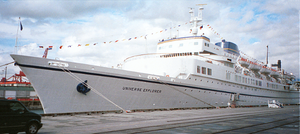SS Brasil (1957)

ex-Brasil as Universe Explorer, 1997
|
|
| History | |
|---|---|
| Name: | Brasil |
| Operator: | Originally, Moore-McCormack Lines |
| Port of registry: | Panama |
| Builder: | Ingalls Shipbuilding, Pascagoula, Mississippi |
| Cost: | $24,444,181 ($203 million today) |
| Sponsored by: | Mrs. Emmet J. McCormack |
| Christened: | December 16, 1957 |
| Completed: | 1958 |
| Acquired: | September 4, 1958 |
| Maiden voyage: | September 12, 1958 |
| Identification: |
|
| Status: | Scrapped in Alang, India starting December 7, 2004 |
| General characteristics | |
| Tonnage: | 14,208 GRT |
| Displacement: | 5,238 DWT |
| Length: | 574.5 ft (175.1 m) |
| Beam: | 88.19 ft (26.9 m) |
| Draft: | 27.25 ft (8.3 m) |
| Installed power: | 35,000 SHP |
| Propulsion: | Twin screw, General Electric DR Geared Turbines |
| Speed: | 23 knots (43 km/h; 26 mph) |
| Capacity: | 557 passengers |
SS Brasil (1957) was an ocean liner launched at Ingalls Shipbuilding in Pascagoula, Mississippi in 1957. The ship was originally named Brasil for Moore-McCormack's South American service, but was renamed a number of times. During its history the ship served as a cruise ship and later served in the Semester at Sea program as Universe Explorer. The ship was scrapped in Alang, India, in 2004 sailing under the name Universe for the final voyage.
Brasil was a replacement for Moore-McCormack's SS Brazil (1928). Brasil and her sister ship, Argentina, used MARAD Design P2-S2-9a. Construction was subsidized by the United States Maritime Administration under title V, sections 501 and 504 of the Merchant Marine Act of 1936. At the time of her construction, Brasil was said to be the largest ship built in the "deep south".
Ingalls Shipbuilding had the lowest US bid at $24,444,181 ($203 million today) for each of the two ships. The Maritime administration subsidized the cost of construction by paying $19,528,362 ($162 million today) to support the US shipbuilding industry. Meaning that the ships would have cost nearly $20 million less if they had been built outside the United States. As of 2015, Brasil and Argentina were among the last luxury liners built in the United States.
Design included Denny-Brown stabilizers, a system of retractable fins to stabilize the ships in heavy seas. The ship design originally included a solarium for nude sun tanning inside the false funnel.
Naming history: Brasil → Volendam → Monarch Sun → Volendam → Liberte → Canada Star → Queen of Bermuda → Enchanted Seas → Universe Explorer → Universe.
...
Wikipedia
